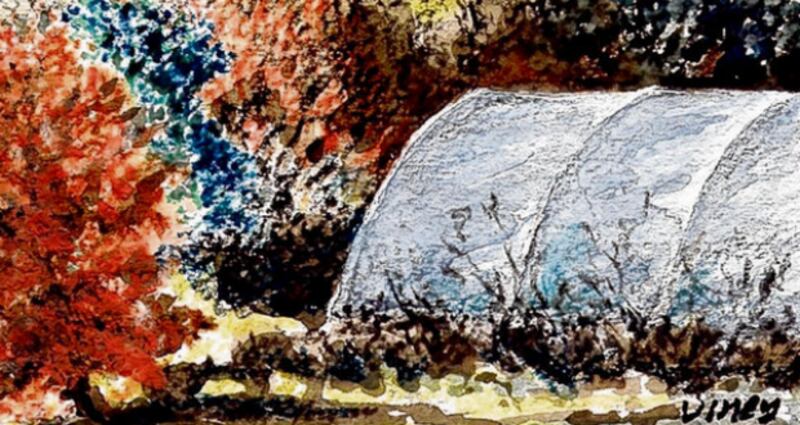The tunnel could look a bit ugly anywhere else: you might not want it in the neighbour’s garden, or even your own. But nestled discreetly in our sheltering tangle of trees it can even have flashes of beauty, as when a full moon lights mysterious fairy candles along its canopy or a setting sun glows silkily in folds of polythene.
Just now the plastic is misted on both sides with winter algae, which, along with overhanging branches, defeats the optimal spread of light. As I scrub off the green film with a window-cleaning yoke, I ponder those black splashes on the plastic beneath the sycamore. That must, I conclude in a rare eureka moment, be summer aphids sucking at the tree and dripping surplus, sugary honeydew from their rear ends.
Without clouds of wasps or butterflies to lap it all up, it made a perfect substrate for the growth of sooty mould.

Such interests add to one’s pleasure in the special ecosystem of the polytunnel but scarcely matter to its main role for an oldie, which is as sanctuary, kingdom and passport out of time, never mind extending the seasons or even working on when hail showers are rattling off the roof. What matters in this arching envelope of luminosity is the perennial, ageless redemption of making things grow again.
With a canvas chair in which to pause from measured stoopings and kneelings, a radio wedged high in the rigging in the one perch that gets Lyric properly, a mobile in my pocket for spousely summons or comfort, this is my special oasis on the planet. “Good morning, tunnel!” I cry foolishly, heaving back the door. (Prince Charles is not alone in talking to his plants.)
What’s there at the moment? Broad beans budding into flower, mange-tout peas halfway up, a sudden swelling of overwintered cauliflowers. Salad stuff, of course, and young beetroot, spinach and chard; the first bright spears of garlic. Early potatoes bide their time in a bed dressed with compost from the worm bin and wood ash from the stove. Up in the house, on a warm window sill, three kinds of tomatoes push up their first leaves; peppers and aubergines, too.
Darwin’s greenhouse
Darwin would have loved a tunnel. He did build himself a greenhouse, but his mysterious tummy troubles meant that some of his most momentous experiments with plants had to take place in his study.
He found answers to just the same questions that grab us still. Young pea plants reach out their tendrils to coil around wire netting – but how did they know it was there? And how do their stem cells engineer that tight, spiralling grip? “I have had a sudden access of furor about climbers,” Darwin wrote to his friend Joseph Hooker in 1864, and in no time, helped by his son Frank, his sick couch was surrounded by climbing plants in pots: runner beans, wild cucumbers, nasturtiums, clematis and dozens more.
Tropical house plants and vines filled every surface and shelf. As hops spiralled up their sticks, he tied weights to their tips to try to slow them down. Vines became covered with paint marks as he timed their twisting movements.
Plants, as they grow, respond to many forces at once: the pull of light and warmth, the push of wind, the weight of gravity. But what Darwin discovered was the spiralling, oscillating movement he called “circumnutation” (Latin for circle or sway). This is a waving around at the tip, in repeating circles or elipses, that is common to all plants as they grow. It is part of keeping their balance but also, in climbers, a search for support. (A bean shoot may circle in a radius of up to 10cm.)
Plants vary in this movement and the time they take to gyrate: tulips take four hours, wheat about two. Darwin painstakingly monitored more than 300 species and found circumnutation in all, even plotting it on sheets of glass suspended horizontally above them. But his hypothesis that the spur to spin is inherent in all plants became challenged by those who thought gravity alone was the power at work.
Dr Daniel Chamovitz of Israel, discussing plant senses in What a Plant Knows (Oneworld, 2012), tells how seeds of Arabidopsis (the standard weedy plant of botanical experiment), germinating in the near-weightless International Space Station, showed little spiral movements as they grew. Put on a centrifuge, however, their circlings became much more pronounced, as gravity became a necessary partner in the dance.
As for that grip on the stick, it’s the first touch that counts. As the tendril brushes the support, the cells immediately in contact stop growing, while those on the opposite side continue to elongate, pushing the tendril round into a spiral. For our ordinary peas and beans, this, too, can take hours – too long, perhaps, to keep watching, even in your polytunnel chair.
Eye on Nature Your notes and queries
Our first brambling in 20 years came to our bird feeders at the start of last month.
Bonnie Mullen
Riverstown, Co Louth
Bramblings are uncommon but regular visitors from northern Europe, mainly to coastal areas.
On February 13th I was surprised to see three Mediterranean gulls among black-headed gulls in Kilbogget Park. Is this normal so far from the coast, and are they now a breeding species?
John Kelly
Killiney, Co Dublin
They are regular winter visitors but a rare breeding species.
I have put up a bird feeder with a selection of seeds, peanuts and fat balls. One day I looked out and saw 14 yellowhammers waiting for tits to vacate the feeders.
Joe O’Sullivan
Naas, Co Kildare
On our pond there are a few mating frogs. One female is sandwiched between two males and looks distinctly unhealthy.
Michael and Rosalind Callander
Ballyglass, Co Mayo
Female frogs can be fatally gang-raped.
Michael Viney welcomes observations at Thallabawn, Carrowniskey PO, Westport, Co Mayo, or email viney@anu.ie. Please include a postal address






